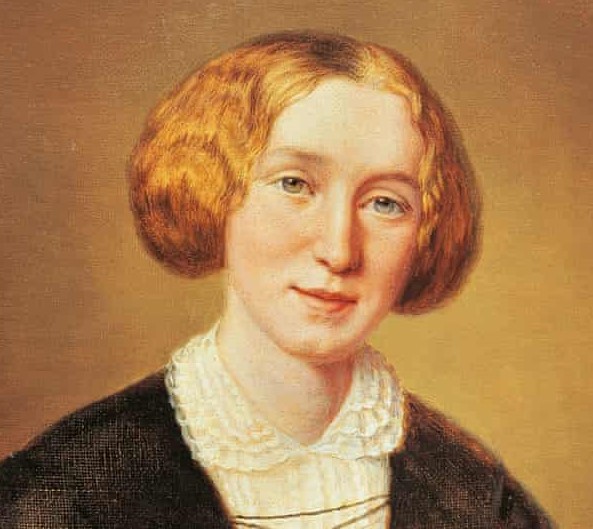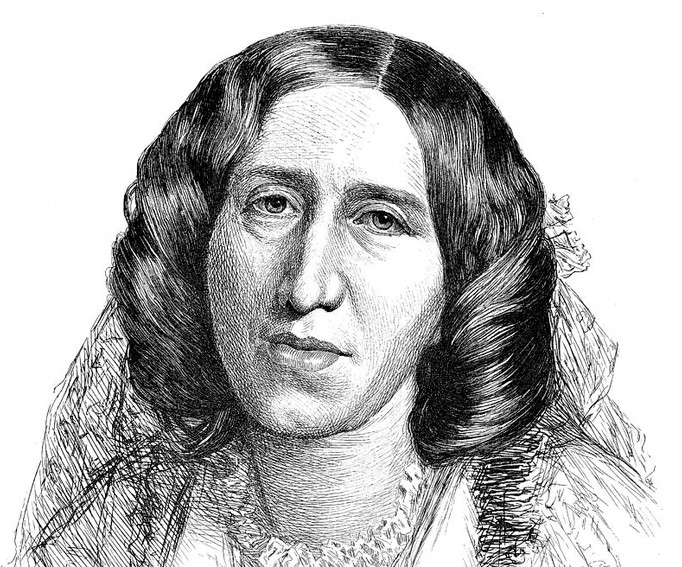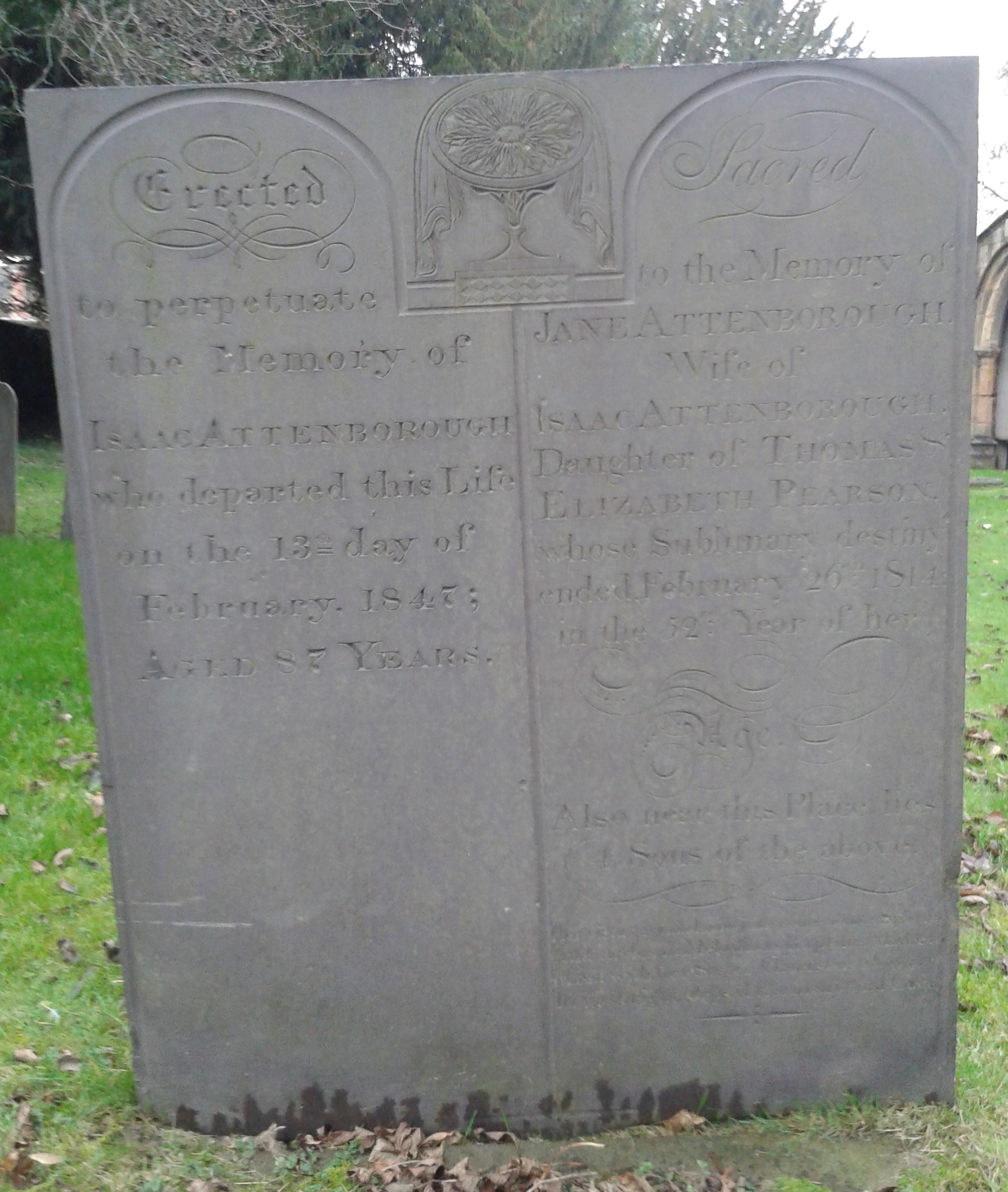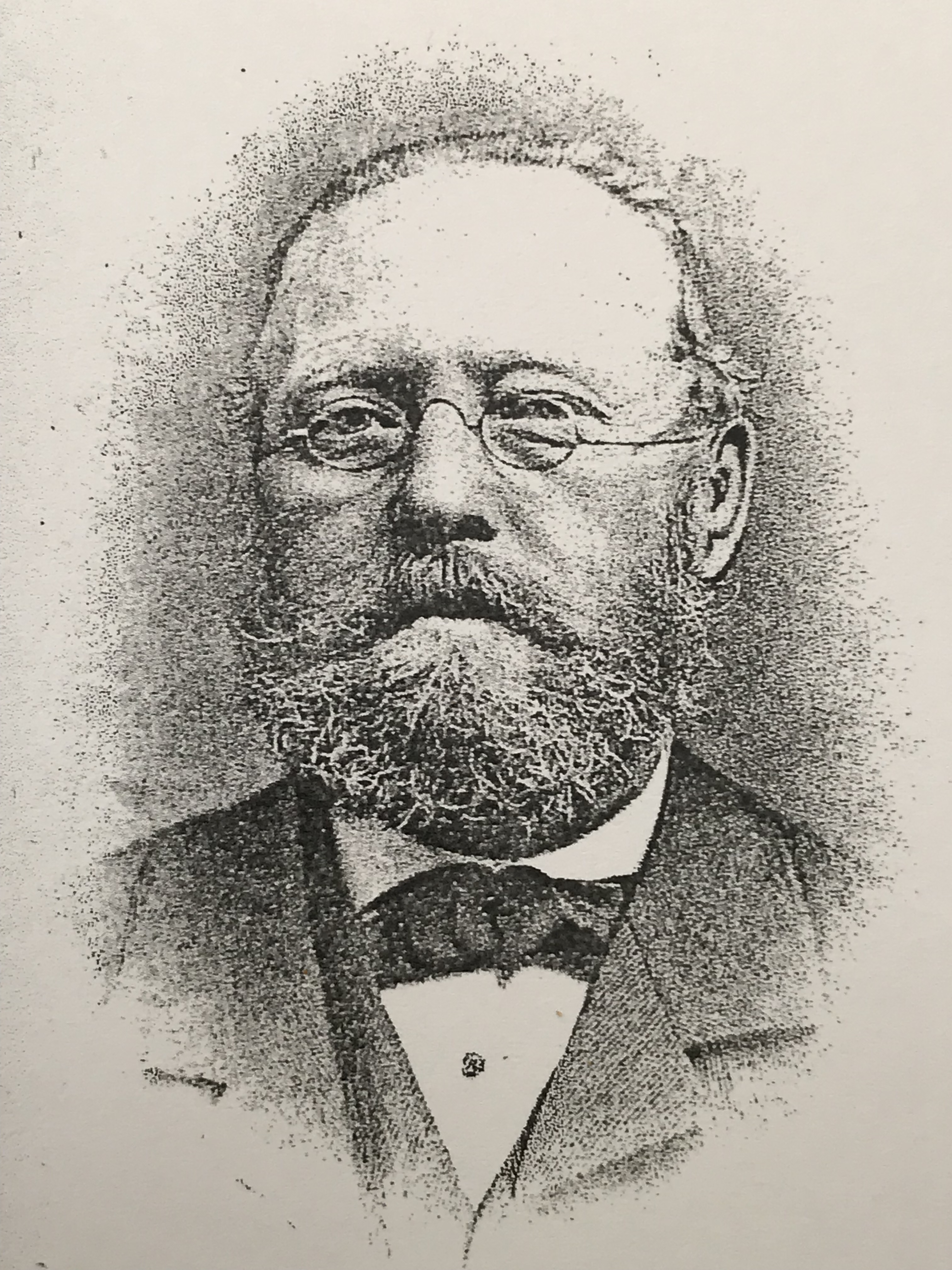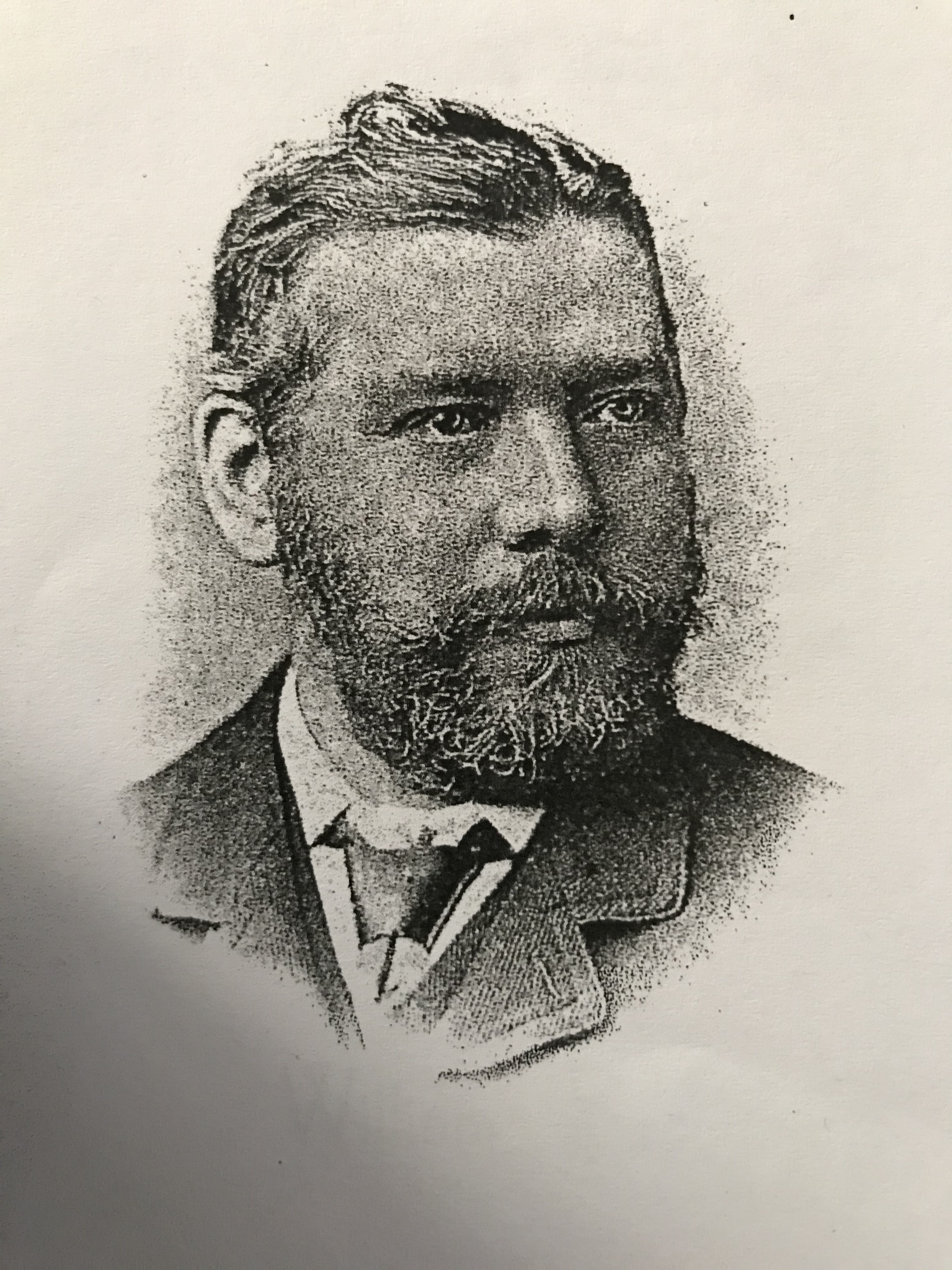“In Oakwell Fields, Oak Well Farm House was occupied by the Marshall family.”
The Attenborough family at Oakwell Farm
The farm was at 10 Derby Road — just before the Miners’ Arms at the corner of Belper Street and Derby Road — bordered by a grass verge while a green hedge served as a fence behind. Its front faced the south/south-west while its back was to Derby Road.
Isaac Attenborough and the Evans family
In 1861 the farm was occupied by Isaac Attenborough and his family. It is reputed that he was born at the Sir John Warren in 1790, the son of Isaac senior and Jane (nee Pearson) and younger brother of Mark Attenborough.
Following his death on April 22nd 1862 the farm premises and all the goods and stock contained in it were sold.
Isaac Attenborough’s legacy
When Isaac junior died in 1862 he was a widower. He had married Mary Fletcher — the daughter of Joseph and Sarah (nee Pearson) and thus his own first cousin — in July 1814, but she had died of chronic bronchitis at the Oakwell farm in August 1857, aged 66. By that time their only child, daughter Jane, had married (May 10th 1831) farmer Robert Evans.
The eldest child of this union was Isaac Attenborough Evans, born in 1831, a farmer who married Ann Fletcher, daughter of Joseph and Ann (nee Brooks) on September 19th 1876 — his wife may also have been his first cousin once removed as well as his second cousin once removed. Isaac was a main beneficiary from his grandfather’s will.
In his will Isaac Attenborough left all his property to his daughter and her husband ‘for and during the term of their joint natural lives and the life of the survivor of them ‘.
When both had died the will declared that Isaac’s property at Stanley — the farm known as Stanley Lodge — was to pass to Isaac Attenborough Evans — Isaac’s oldest grandson.
The sum of £500 was to be paid to each of his other grandsons, Robert Evans junior, Walter Sacheverel Evans and Alfred Henry Evans.
Also, again after the deaths of both Robert and Jane, all four Evans grandsons were to share Isaac’s other land, listed in the will ‘in or near to Park Road or Millfield Road‘, amounting to about 20 acres in area, tenanted at that time by William Thompson, Robert Marshall, Edmund Tatham and Bartholamew Wilson.
Other land in Breaston — about 14 acres — was left to grandson Alfred Henry Evans, again after the death of both his parents.
There were several ‘ifs’ and ‘buts’ attached to these main bequests, concerning early deaths and ‘age of majority’ though these did not alter the main beneficiaries.
————————————————————————————————————————————
Now Robert Evans, born in Ellastone, Staffordshire in March 1802 but baptised at Kirk Hallam All Saints Church in October of that same year, was the elder child of Robert senior and his first wife Harriet (nee Poynton). There was one other child — daughter Frances Lucy Evans, born in 1805 — before Harriet Evans died in 1809 (?)
Four years later — in February 1813 — Robert senior married his second wife, Christiana Pearson (daughter of Isaac and Ann (nee Baker)?) and five more children followed. The two youngest, twins William and Thomas, died in infancy in 1821. The other children survived into adulthood.
Of the three surviving children …
.. the eldest was Christiana Evans (1814-1859) who married surgeon/general practitioner Edward Clarke in 1837. The couple then lived in Meriden, Warwickshire, where their children were born and where Christiana died.
… the only son, Isaac Pearson Evans (1816-1890) seems to have lived his life at Griff House near Chilvers Coton, Warwickshire, as a farmer and land agent, raising a family with his wife Sarah (nee Rawlins).
… which leaves the remaining child of Robert and Christiana Evans — Mary Ann Evans, born on November 22nd 1819 and baptised a week later at Chilvers Coton.
When her ‘formal’ education ended at the age of 16, Mary Ann lived with her father as housekeeper until his death in 1849. By that time she had been exposed to new influences through her expanding circle of friends some of whom championed philanthropic causes, challenged established religious thought and caused Mary Ann to question her own beliefs. She had already begun to write … newspaper articles, reviews and translations …
…. and this led to Mary Ann turning to the writing of short stories and then novels, under the name of George Eliot (adopted about 1857). Of course her life and achievements have been well-documented .. even to some extent in the Ilkeston Advertiser.
———————————————————————————————————————————————–
From the Sir John Warren Inn in the corner of Ilkeston Market Place to Middlemarch .. via Attenborough
In 1933 the Ilkeston Advertiser published a series of articles by ‘Tilkestune’ in which he contemplated the life if Isaac Attenborough junior, the Evans family and the work of Mary Ann alias George Eliot.
George Eliot: detail of an etching by Paul-Adolphe Rajon after a 1865 chalk drawing by Frederick William Burton.
The following is taken from those articles, with a few of my own notes.
When Robert Evans, father of George Eliot left Kirk Hallam to return to Warwickshire, near Nuneaton, he left behind him several members of his family, including one who was his namesake. This son married Jane, the daughter of Isaac Attenborough.
Robert Evans junior was a brother — probably the eldest brother — of George Eliot the novelist , whose great novel entitled ‘Middlemarch’ was written in part about herself and her partner George Lewis (sic) — (‘Dorothea Brooke’ being George Eliot idealised, and moved up into the gentry, while ‘Will Ladislaw’ is the literary man Lewis)
(The partner of Mary Ann Evans was married literary critic George Henry Lewes with whom she lived from 1854 until his death in 1878. George Henry shared an ‘open marriage’ with his wife Agnes (nee Jervis) whom he had married in 1841.)
Whether a little girl named Mary Ann Evans, Robert’s half-sister, came over from Nuneaton for the wedding (of Robert and Jane in 1831), cannot now be ascertained, but we can see it was such an eventas would have delighted her heart, for this future genius was only four years younger than the bride.
She had a great love for Kirk Hallam, where her brother Tom is given in Bagshaw (1846) as tenant of the farm, and here she came in later years when estranged from her father on account of intellectual differences, and later still when, famous as the author of ‘Adam Bede’ and other novels, she wished to escape for a time from public notice….
[Thomas Evans senior, farmer of Kirk Hallam, was the uncle of Mary Ann not her brother. Thomas junior, son of Thomas, also a farmer of Kirk Hallam, was her first cousin]
(Middlemarch) is in part about an Ilkeston family whom she calls the Featherstones ….. It was (at Kirk Hallam) that (Mary Ann) was introduced through her brother’s marriage to the ‘Featherstones’, who on their part, referred to her to the end of their lives, as ‘Miss Evans’. Fifty years ago I was corrected by several Featherstones at different times and in various places, miles apart, for speaking of ‘Miss Evans’ as ‘George Eliot’.
(At Kirk Hallam) she planned ‘Middlemarch’, here and at Ilkeston (Freshitt), and at Nottingham (Middlemarch) along with her nephew (Robert), the second son of Robert and Jane, who became an architect and land agent at Nottingham.
Robert and Jane had in the course of time a family of four sons and two daughters, and I believe some of their children a generation later may have served as models for the children in ‘Middlemarch’.
In a post-script, ‘Tilkestune’ states that the Evans children numbered seven, as ‘they lost one in 1853. There is a record of a death of Arthur William, (their) son, on March 27th of that year, at the age of thirteen months, at Stanley.
(Robert and Jane had at least nine children — six sons and three daughters — born between 1831 and 1855. One son, William Henry, died in infancy and one daughter, Harriet, died aged 12. The others seem to have survived into adulthood)
—————————————————————————————————————————————————–
‘Tilkestune’s’ account of Isaac Attenborough and Oakwell farm. (extracts from the Ilkeston Advertiser Feb-May 1933)
According to tradition Isaac Attenborough lived at a farmhouse a little distance below the Bull’s Head, on the same side of the road, and perched on the top of a piece of high land.
Four days after his death, Isaac Attenborough’s funeral cortege passed down the road from Little Hallam (where he had lived some time before his death at the house a little away from the bank at the right side of the road looking west) on its way to Kirk Hallam Church for the funeral rites which were conducted by the Rev. Alfred Newdigate, the then Vicar of the parish.
(Isaac) appears to have first set up as a publican and farmer, for his name is in Bagshaw’s Register in 1846 as licensee of the Newdigate Arms Inn, Lewcote Gate, on Derby Road, West Hallam. From there he removed to Oakwell Farm, Derby Road, Ilkeston, afterwards occupied by the Sudburys, and it is still as ‘of Oakwell Farm’ the interment was entered in the parish register at Kirk Hallam.
At that time no farm in the parish of Ilkeston had such a beautiful lay as this, and before the construction of the waterworks there was a footpath leading from Derby Road past the old well of spring water which gives the name to the farm, and ending near the bridge. By this path the Evanses who remained behind after their father’s removal to Nuneaton, as well as the villagers generally, came to Ilkeston.
From the Ilkeston side the scene was truly pastoral, and in the distance was the tower of Kirk Hallam Church, peeping out from abundant foliage. On a Sunday morning and afternoon the sound of the bells floated over the whole area of the farm and beyond.
There is no stone of commemoration to Isaac and his wife Mary to-day, but it is hardly believable that one did not exist once.
Of what family Isaac Attenborough’s wife came I have not found, but I may mention that his daughter Jane was named after her paternal grandmother, whose remains were interred at Cossall, for what reason doth not appear plainly. There may be an interesting story behind it. She died in what may be called mid-life, and her husband, who is also buried at Cossall, survived her by over thirty years.
[Research facilities are today much improved and far easier to access than when ‘Tilkestune’ was writing his excellent local history. Helped by these developments I have suggested who the wife of Isaac Attenborough was (above).
The paternal grandmother of daughter Jane was born Jane Pearson in Cossall, the child of Thomas and Elizabeth (nee Dennis), baptised there (February 28th 1762) and married there (December 3rd 1782). She died in Ilkeston (February 26th 1814) and her name appears in the burial records of St. Mary’s Church there (March 2nd 1814)].
The gravestone of Isaac and Jane Attenborough at the south side of St. Catherine’s Church, Cossall. The inscription mentions four of their sons buried nearby … these would be Thomas I and Thomas II, John and George.
There is a curious entry in Bagshaw (1846), it is this “Evans, Robert, gent, land agent, the Firs, West Hallam”
It seems to me that this is the Robert Evans who was the son-in-law of Isaac Attenborough, who was living near his wife’s parents for company’s sake, as much as anything. We must not forget that his wife was an only child, and that she had married Robert Evans at what today would be a prohibitive age, quite a girl. as a matter of fact, only fifteen, while, strange to say, her husband was twenty-eight, thirteen years older. The marriage of the girl-bride’s parents had only taken place sixteen years earlier, at Kirk Hallam Church. Her mother was Mary Fletcher, 23, while her father was 24 at the time of their marriage. Mary Fletcher was, I believe, the daughter of a farmer of Mapperley. Isaac and Mary were married in 1814, and Robert Evans and Jane Attenborough in 1930 (a typo… it should read 1830)
[This ‘Robert Evans’ was indeed the son-in-law of Isaac Attenborough, though he married Jane in 1831, not 1830 — ‘Tilkestune’s calculations are thus a year or so inaccurate. Jane was 16 when she married, while her husband was 29].
We see that in 1846 Robert Evans was living at the Firs, West Hallam. A year or two later he removed to the Lodge Farm, Stanley, a place of 66 acres, and this farm, along with lands and cottages at Ilkeston, Little Hallam and Breaston, was left to him and his wife as tenants for life by Isaac Attenborough in 1862.
Robert Evans did not live long to enjoy this fortune, for he died on January 27, 1864, at the age of 62. His widow lived to the summer of 1881, when she died at Sutton Coldfield, June 15th, aged 66.
Her eldest son, Isaac Attenborough Evans, inherited the Lodge Farm according to his grandfather’s will, and lived to the advanced age of 81. He had relinquished the farm and was living at the Cedars, Borrowash, when he died on March 12, 1912. His wife, Ann, had predeceased him, dying on Jan 14, 1908, aged 75. I have no further knowledge at present of this family.
—————————————————————————————————————————————————
The Sudbury family at Oakwell Farm
In 1867 the Oakwell premises were occupied by William Sudbury, farmer and butcher, the eldest son of hosier and glover Francis and Ann (nee Mather) and brother of Ilkeston’s first mayor.
In the 1870’s many of the farm’s old buildings were pulled down – with the exception of the farm house and a barn at its side. New ones replaced them.
———————————————————————————————————————————————
William remained at the farm until his death in 1891.
His eldest child and butcher Arthur William and family were at the farm for a few years thereafter. In 1875 he had married Sarah Tatham, the younger daughter of Amos and Eliza (nee Bell); they were living there in April 1893 when Arthur William was visiting customers at Stanley and driving his carriage up towards Stanley Hall. His cart made contact with a large stone by the roadside, pitching him out of the vehicle and under its wheels. The result was two broken ribs and a few days of rest.
In the early 1890s Arthur William was trading as a butcher in town and had a shop in East Street. However, about 1893 he moved into 13 Bath Street which he took on a lease, remaining there for about five years. In 1897 his wife Sarah was staying with her widowed mother at the Elms in Stanley Street when Arthur William sold the shop lease to Alfred Burton Wood for £80 … and on the very next day departed for South Africa !!! Sarah knew nothing of the sale or of her husband’s intended ‘visit’ abroad. What she did know was that Alfred had not paid the full cost of the lease and was left owing her husband £30. She was however denied in her efforts to claim that debt, as a court ruled that, because of missing documentation, the contract between Arthur William and Alfred had not been fulfilled. Consequently Sarah wasleft at the Elms, Arthur William was now in South Africa, and Alfred Burton Wood was trading at 13 Bath Street … though it was his son, Charles Stanley Wood, who traded there as a butcher.
The youngest son of William and Mary Sudbury was Frank, born “at the Market Place” on June 28th 1865. He lived nearly all his life at Oakwell Farm and traded as a lace manufacturer. On July 19th, 1892 he married Anna Joanna Jackson Marshall, daughter of Robert and Ann (nee Bentley) and the couple then moved into their new home of Marshall House, 16 Gregory Street. In late August of 1898 Frank fell ill with dysentery and after a two week struggle against the illness, he died on September 1st. For a time, his widow continued to live in Gregory Street with her unmarries sister Mary Ellen, before both of them moved to live at Gregory House, 1 Gregory Street.
The Marshall family at Oakwell Farm
By about 1896 Oakwell Farm was occupied by the Marshall family — Robert and Ann (nee Bentley) who we shall meet in White Lion Square.
—————————————————————————————————————————————————–
This brings us to Belper Street.

